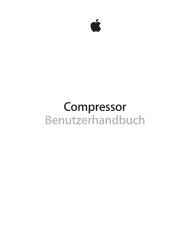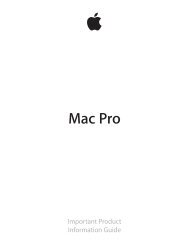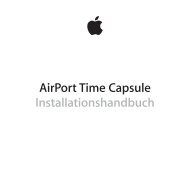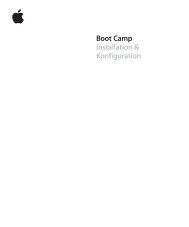iPhone User Guide - Support - Apple
iPhone User Guide - Support - Apple
iPhone User Guide - Support - Apple
You also want an ePaper? Increase the reach of your titles
YUMPU automatically turns print PDFs into web optimized ePapers that Google loves.
Manage content on your iOS devices<br />
You can transfer information and files between your iOS devices and computers, using iCloud<br />
or iTunes.<br />
••<br />
iCloud stores content such as music, photos, calendars, contacts, documents, and more, and<br />
wirelessly pushes it to your other iOS devices and computers, keeping everything up to date.<br />
See iCloud below.<br />
••<br />
iTunes syncs music, video, photos, and more, between your computer and <strong>iPhone</strong>. Changes<br />
you make on one device are copied to the other when you sync. You can also use iTunes to<br />
sync files and documents. See Sync with iTunes on page 18.<br />
You can use iCloud or iTunes, or both, depending on your needs. For example, you can use iCloud<br />
to automatically send the photos you take on <strong>iPhone</strong> to your other devices, and use iTunes to<br />
sync photo albums from your computer to <strong>iPhone</strong>.<br />
Important: If you use iCloud for syncing contacts, calendars, and notes, don’t also use iTunes to<br />
sync those items. Otherwise, you might see duplicates.<br />
You can also manually manage content from iTunes, in the device’s Summary pane. This lets you<br />
add songs and videos, by choosing a song, video, or playlist from your iTunes library and then<br />
dragging it to your <strong>iPhone</strong> in iTunes. This is useful if your iTunes library contains more items than<br />
can fit on your device.<br />
Note: If you’re using iTunes Match, you can manually manage only video.<br />
iCloud<br />
iCloud stores your content, including music, photos, contacts, calendars, and supported<br />
documents. Content stored in iCloud is pushed wirelessly to your other iOS devices and<br />
computers set up with the same iCloud account.<br />
iCloud is available on devices with iOS 5 or later, on Mac computers with OS X Lion v10.7.2 or later,<br />
and on PCs with the iCloud Control Panel for Windows (Windows 7 or Windows 8 is required).<br />
Note: iCloud may not be available in all areas, and iCloud features may vary by area. For more<br />
information, see www.apple.com/icloud.<br />
iCloud features include:<br />
••<br />
iTunes in the Cloud—Download previous iTunes Store music and video purchases to <strong>iPhone</strong><br />
for free, anytime. With an iTunes Match subscription, all your music—including music you’ve<br />
imported from CDs or purchased somewhere other than iTunes Store—appears on all of your<br />
devices and can be downloaded and played, on demand. See iTunes Match on page 64.<br />
••<br />
Apps and Books—Download previous App Store and iBook Store purchases to <strong>iPhone</strong> for free,<br />
anytime.<br />
••<br />
Photos—Use My Photo Stream to push photos you take with your <strong>iPhone</strong> to your other<br />
devices, automatically. Use iCloud Photo Sharing to share photos and videos with just the<br />
people you choose, and let them add photos, videos, and comments. See iCloud Photo<br />
Sharing on page 73 and My Photo Stream on page 74.<br />
••<br />
Documents in the Cloud—For iCloud-enabled apps, keep documents and app data up to date<br />
across all your devices.<br />
••<br />
Mail, Contacts, Calendars—Keep your mail contacts, calendars, notes, and reminders up to date<br />
across all your devices.<br />
Chapter 2 Getting Started 17
















